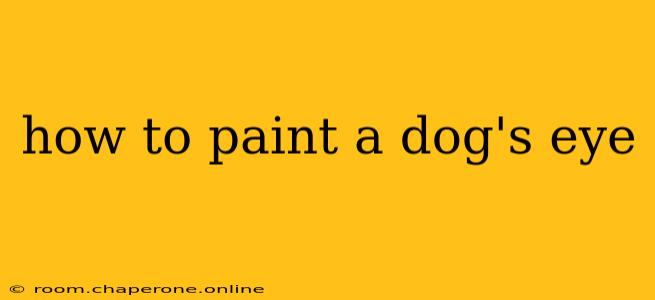Painting an animal's eye, especially a dog's, presents a unique challenge. The expressiveness inherent in a canine gaze requires careful attention to detail and an understanding of light, shadow, and form. This guide will walk you through the process, offering techniques suitable for beginners and tips to refine your skills as you progress.
Understanding Canine Eye Anatomy
Before you pick up your brush, it's crucial to understand the basic anatomy of a dog's eye. Unlike human eyes, a dog's eye often features a more prominent nictitating membrane (third eyelid), a darker, rounder pupil, and sometimes a slightly different shape to the overall eye structure depending on breed. Observe reference photos closely – paying attention to these details will dramatically improve the realism of your painting.
Key Features to Note:
- Pupil Shape: Typically round, but can appear slightly oval depending on the breed and lighting.
- Iris Color: Varies widely, from deep brown to striking blue, green, or amber. Observe the subtle variations within the iris itself; it's rarely a uniform color.
- Highlights: These are crucial for bringing life to the eye. They capture the light reflecting off the cornea and give the eye its shine. Often, there are multiple highlights, not just one.
- Shadows: Equally important are the shadows, which define the form and create depth. Look for shadows within the iris, around the pupil, and in the corners of the eye.
- Nictitating Membrane: This third eyelid is often partially visible in the inner corner of a dog's eye, appearing as a translucent, pinkish-white membrane.
- Tear Duct: A small, often darker area in the inner corner of the eye.
Materials and Techniques
The materials you choose will impact your painting process. Here's a suggested list, but feel free to experiment with your preferred medium:
- Paints: Acrylics, watercolors, or oils – each offers unique characteristics and challenges.
- Brushes: A variety of sizes, from fine detail brushes (size 000 to 2) for intricate work to larger brushes for laying down base colors.
- Palette: For mixing your paints.
- Canvas or Paper: Choose a surface that complements your chosen paint type.
- Reference Image: A clear, high-quality photograph of a dog's eye is essential.
Step-by-Step Process:
-
Sketching: Begin with a light sketch of the eye's basic shape, including the pupil and iris. Don't overwork this stage; it's merely a guide.
-
Base Colors: Apply a thin layer of base color for the iris. Mix your colors carefully to achieve the right shade and tone.
-
Highlights: Once the base is dry, add your highlights using a lighter, brighter color. Use a small, fine brush to create small, precise highlights. Remember multiple light sources will create multiple highlights.
-
Shadows: Add shadows using a darker shade of your base color. Blend these smoothly to create depth and form. Pay close attention to the areas where the eyelids meet the eye.
-
Details: Refine the details, such as the pupil, tear duct, and nictitating membrane. Use the smallest brush for this stage.
-
Final Touches: Step back and assess your work. Make any final adjustments to balance the light and shadow, ensuring the eye looks realistic and expressive.
Tips for Advanced Artists
- Glazing: For a more luminous effect, consider using glazing techniques. This involves applying thin, transparent layers of color over each other to build depth and richness.
- Blending: Practice smooth blending techniques to create seamless transitions between light and shadow.
- Texture: Experiment with different brushstrokes to create texture and movement within the eye.
- Study Masters: Analyze the work of master animal painters to gain inspiration and insights into their techniques.
Conclusion
Painting a dog's eye is a rewarding challenge that can significantly improve your artistic skills. By understanding the anatomy, employing proper techniques, and practicing regularly, you can capture the captivating beauty and expressiveness of a canine gaze in your artwork. Remember to always practice patience and observe your reference images closely. The key to success lies in meticulous attention to detail and a keen understanding of light and shadow.

